|
|
|
| Malocclusion And Zodiac Signs: A Correlative Study |
Mridula Trehan 1 , Sunil Sharma 2 , Vikas Jharwal 3 , Nidhi Rathore 4 , Ankur Mangal 5
1 Professor and HOD, Department of Orthodontics - Mahatma Gandhi University Of Medical Sciences & Technology Jaipur, India
2 Principal, Department of Oral and Maxillofacial Surgery - Mahatma Gandhi University Of Medical Sciences & Technology Jaipur, India
3 Senior Lecturer, Department of Orthodontics - Mahatma Gandhi University Of Medical Sciences & Technology Jaipur, India
4 Senior Lecturer, Department of Orthodontics - Mahatma Gandhi University Of Medical Sciences & Technology Jaipur, India
5 PG Student, Department of Orthodontics - Mahatma Gandhi University Of Medical Sciences & Technology Jaipur, India
|
| Address For Correspondence |
Dr. Mridula Trehan
Professor and HOD,
Department of Orthodontics
Mahatma Gandhi University Of Medical
Sciences & Technology Jaipur, India.
Email Id – Mridula.Jaipur@gmail.Com
Mobile No. 919829008289 |
| Abstract |
| The etiology of malocclusion still remains a dilemma as it is difficult to prove a single major cause of malocclusion. The main aim of this study was to evaluate malocclusion among the individuals of different Zodiac signs. Our study included 600 healthy individuals in the age range of 16 to 30 years. This study comprised of 50 subjects under each of the twelve zodiac sun signs. Statistical analysis with ANOVA test showed that the variation of Zodiac Sun Signs with malocclusion was highly significant. Among all the Zodiac Sun Signs, Aries and Taurus had the highest prevalence of class II malocclusion. Capricorn was found to have the highest prevalence of class III malocclusion which was statistically highly significant. Thus we can say that there is a relationship between malocclusion and zodiac signs. Thus, it can be said that the Zodiac signs do have a role in determining malocclusion. |
|
| Keywords |
| Zodiac Sun signs, malocclusion, preventive dentistry |
|
| Full Text |
Introduction
Part of the philosophy of the early orthodontists was their belief in the perfectibility of man. Edward Angle and his contemporaries, influenced by the romanticized view of primitive peoples commonly held 100 years ago, took it for granted that malocclusion was a disease of civilization and blamed it on improper function of the jaws under the “degenerate” modern conditions. Classical (Mendelian) genetics developed rapidly in the first part of the twentieth century, and a different view of malocclusion gradually replaced the earlier one. As the 21st century moves ahead, a more balanced view seems to be emerging. Contemporary research has refuted the simplistic picture of malocclusion as resulting from independent inheritance of dental and facial characteristics, but the research findings consistently have shown also that there are no simple explanations for malocclusion in terms of oral function.[1] The etiology of malocclusion still remains a dilemma as it is difficult to prove a single major cause of malocclusion. Most researches have proposed two broad sets of theories to explain the cause of malocclusion, one of which is based on genetics and the other points to the role of environment.[2] Malocclusion is an appreciable deviation from the ideal occlusion that may be considered aesthetically unsatisfactory.[3] Keeping this view in mind, an attempt is being made to correlate malocclusion with the Zodiac Sun Signs.
Aims & Objectives
The main aim of this study is to evaluate malocclusion among the individuals of different Zodiac signs. This unique study is also being done with a purpose as to whether a particular ‘Zodiac Sun Sign’ can predict an individual’s malocclusion in the same way as other aspects of the person concerned are being predicted.
Materials & Methods
The subjects of this particular study included 600 apparently healthy individuals of both the sexes. They were randomly selected from various colleges in Jaipur and were in the age range of 16 to 30 years. Subjects were asked to bring a copy of their birth certificate. Since the individuals came from different sections of the society, it in itself removed any bias. The Zodiac sun signs are based on the date of birth as mentioned in Table 1.
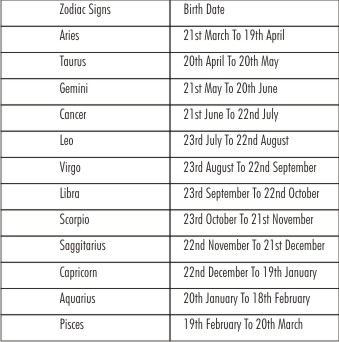 | Table - 1 : Zodiac Signs Based On Date Of Birth
 |
The malocclusion of all the subjects was assessed and recorded in a chart in a systematic manner. This study comprised of 50 subjects under each of the twelve zodiac sun signs. Their statistical analysis (ANOVA test) and their distribution in normal occlusion and malocclusion are shown in Tables 2, 3 and 4 and Charts 1 and 2. Various types of malocclusions were then compared among the 12 sun signs.
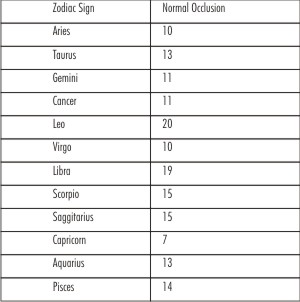 | Table - 2 : Distribution Of Normal Occlusion Among Different Zodiac Signs
 |
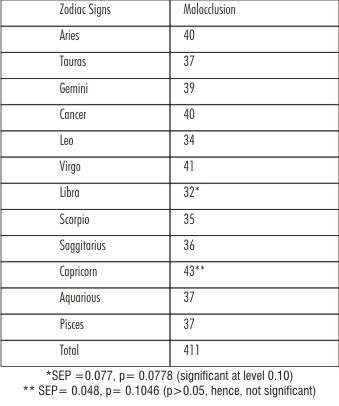 | Table - 3 : Distribution Of Malocclusion Among Different Zodiac Signs
 |
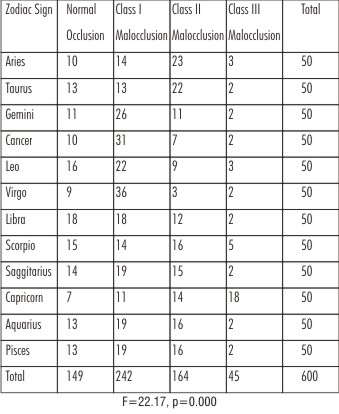 | Table - 4 : Statistical Analysis With Anova Test
 |
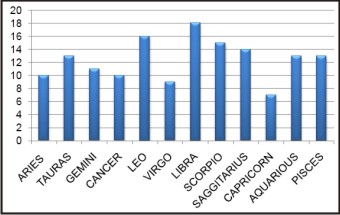 | Chart - 1 : Distribution Of Normal Occlusion Among Different Zodiac Signs
 |
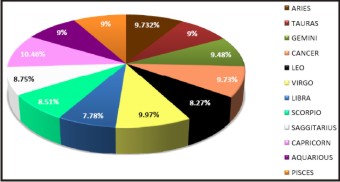 | Chart - 2 : Percentage Distribution Of Malocclusion Among Different Zodiac Signs
 |
 | Fig - 1 : Zodiac Sun Signs
 |
Results And Discussion
Table 3 shows that the highest prevalence of malocclusion was found in Capricorn and the least prevalence was found in Libra which was statistically significant.
Statistical analysis with ANOVA test in Table 4 shows that the variation of Zodiac Sun Signs with malocclusion is highly significant (P<0.001). Among all the Zodiac Sun Signs, Aries and Taurus had the highest prevalence of class II malocclusion. Capricorn was found to have the highest prevalence of class III malocclusion which was statistically highly significant. Thus we can say that there is a relationship between malocclusion and zodiac signs.
A survey of Angle's classes in a sample of Native American Chippewa Indian children and adolescents (6 to 18 years of age) living in Minnesota was conducted to study the frequencies of Class I, Class II and Class III malocclusion. The frequencies of total malocclusion and Class I malocclusion in Chippewa Indian children were high, whereas the frequencies of Class II and Class III malocclusion were lower or similar to that of white or black American adolescents.[4]
Helm studied malocclusion in 1700 Danish children and adolescents 9 to 18 years of age and found that about 14% had normal occlusion, 58% had Class I malocclusion, 24% had Class II malocclusion, and about 4% had Class III malocclusion. [5]
Brunelle, Bhat, and Lipton reported the incidence of certain occlusal traits in noninstitutionalized people in the United States among three racial groups (whites, black and Mexican-American).[6]
Conclusions
Thus, it can be said that the Zodiac signs do have a role in determining malocclusion. No previous studies have been reported in this regard. Further studies on a large sample size may be quite interesting and there will be a day when we can predict malocclusion just by knowing the Zodiac sun sign. This may be helpful in Preventive dentistry too.
References
1. William R. Proffit: 1986: fourth edition 2007. Contemporary orthodontics. St. Louis, Missouri: Elsevier’s Health sciences Rights Department in Philadelphia, PA, USA. Pagee no.158-159.
2. Kudva S, Bhat AP. Teeth and numerology from zodiac signs. A correlative study. Indian J Dent Res. 2000 Apr-Jun;11(2):71-4.
3. Hassan Ra, Rahimah AK. Occlusion, malocclusion and method of measurements - an overview. Archives of Orofacial Sciences (2007) 2, 3-9.
4. Grewe JM et al: Prevalence of malocclusion in Chippewa Indian children, J Dent Res 47:302-305, 1968.
5. Helm S: Malocclusion in Danish children with adolescent dentition: an epidemiologic study, Am J Orthod 54:352-366, 1968
6. Brunelle JA, Bhat M, Lipton JA: Prevalence and distribution of selected occlusal characteristics in the US population, 1988-1991, J Dent Res 75(Spec Iss):706-713, 1996.
|
|
|
|
|
|
|